Outboard engine sales continue to surge on the strength of constant innovation
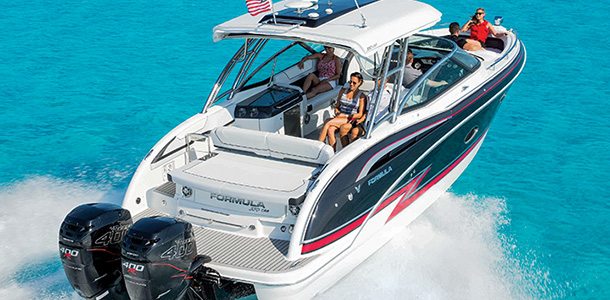

The growth in recreational boating over the past several years has been achieved in large part due to corresponding advances in outboard power. It’s impossible to walk through any consumer boat show these days and not be struck by the overwhelming prevalence of outboard engines. From lightweight portables to behemoth V8s, outboard engines continue to dominate sales figures not just here in the U.S., but all around the world.
According to the latest data from the National Marine Manufacturers Association, sales of new outboard-powered boats have been growing steadily for the past six years. From annual retail sales to the order of 100,000 units in 2011, NMMA shows retail volumes charting steadily upward through September 2016 – the most recent data released – when they approached the 150,000-unit range. That is a substantial rate of growth by any measure and today four out of five new powerboats sold are powered by an outboard engine.
Freshwater fishing boats currently represent 45 percent of all outboard boats sold, notes NMMA, followed by pontoon boats (32 percent) and saltwater fishing boats (19 percent). Yet it is the rapid growth in the pontoon and saltwater fishing categories that have driven the sharpest gains in outboard engine sales, as these segments continue to achieve year-over-year growth rates in the high single-digit and low double-digit range.
“Pontoon boat sales continue to grow year after year, which obviously represent a direct benefit to outboard manufacturers,” said Evinrude product marketing manager Jason Eckman. “Today’s pontoon boats have evolved to such a degree that they’re nothing like what they were even 10 years ago. The boats get bigger and they’re continually pushing boundaries with more and more amenities, but buyers still want to have an exciting ride and a bit of performance. This has been driving demand for larger horsepower outboards for some time, and now we’re seeing multi-engine pontoons emerge on the market from several different manufacturers. At one point this might have been considered a completely outrageous idea, but as more people experience it and enjoy the performance edge that twin engines bring, multi-engine pontoons have begun to emerge as a bit of a growing trend, while focusing even more attention on the pontoon segment and driving further sales.”
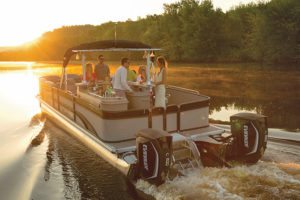
It isn’t just pontoons which have grown larger and come to demand bigger engines. The entire boating market seems to be experiencing an upshift as consumers gravitate to increasingly larger product.
“Boating is getting bigger, but not in the sense that everyone’s out there buying 350s and 400s,” said David Foulkes, vice president and chief technology officer at Mercury Marine parent Brunswick Corp. “The distribution curve is definitely moving up. People who previously would have bought a 60 are now buying a 75, for example, and people who would have bought a 90 in the past are now more likely to buy a 115. The overall volumes in that mid-range are still higher than for the very top end, but the whole curve is sliding upward. Our new 350 and 400 recognize that upward shift and provide new options for those customers who would have previously bought a 250 or a 300.”
Steady growth in the saltwater fishing segment has also driven demand for outboards, and in particular for the high-power units that carry the greatest margins.
“Certainly we’ve seen significant, sustained growth in that category,” said Gus Blakely, vice president / division head at Suzuki. “Saltwater fishing has become a huge market for large outboards, as boat builders keep upping the ante with 35-, 40- and 50-foot center consoles that do more than just fish. But in addition to that, or maybe because of it, more recently we’re seeing the entire fiberglass recreational boat market begin to rebound. It’s coming back in a major way, and further driving outboard sales. There are boatbuilders such as Stingray and Formula which used to use sterndrives exclusively or near exclusively, and they’re now introducing boats with outboard power. Their dealers can now sell the boat they’re familiar with, but with all the added benefits that an outboard brings, like more cockpit space or being able to tilt the motor up out of the water when it’s not in use. The impact of that is significant.”
Indeed, fiberglass runabouts in the 16- to 30-foot category now represent a significant portion of the overall outboard market, according to Grand Rapids, Michigan-based Statistical Surveys, Inc. In its data from December 2016, SSI shows fiberglass outboard-powered runabouts marking a staggering year-over-year sales increase of 21 percent. This far outpaces year-over-year growth for other outboard-powered categories like pontoons, saltwater fishing, aluminum fishing and bass boats, and represents the only outboard-powered boat category to post double-digit growth.
The hot market
Outboards not only enjoy massive market share right now, their slice of the pie seems to grow bigger every year. SSI data shows sales of 127,981 outboard-powered boats of all types in 2012, growing to 136,488 units in 2013, 146,818 units in 2014, 157,052 units in 2015 and 165,435 units in 2016.
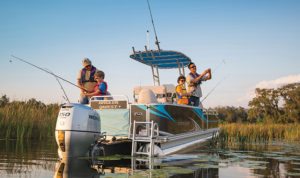
Contrast this to a corresponding decline of sterndrive-powered boats over the same period, with volumes of 16,666 units in 2012, 15,060 in 2013, 13,923 in 2014, 12,941 in 2015 and 12,472 last year.
“Prior to the downturn the cast iron sterndrive market was doing really well,” said Honda Marine OEM sales manager Dennis Ashley. “But coming out of the downturn the market shifted strongly over to pontoons, and cast-iron sterndrives fell out of favor. As a result, the fiberglass boat builders started bringing out new outboard-powered deck boats and runabouts that are really nice, and designed to be able to compete head-on with pontoons. They’ve gained some momentum and I think they could be the next leader in the market. A lot of these are 3,000-pound boats that take 300 horsepower engines, and over the past couple of years that’s a big part of where the growth in sales of larger outboards is coming from. People want a sporty ride, and it all comes down to that power-to-weight ratio which inevitably favors outboards.”
Additional factors cited by boatbuilders in favor of outboards include easier maintenance, increased cockpit space, and quieter operation.
“The market shift to outboard power has been closely associated to the types of boats that consumers want to buy today,” Foulkes said. “Outboard-powered deck boats are creating demand for outboard engines in a segment of the market where there wasn’t much demand 10 or 15 years ago. People are buying outboard-powered pontoons today, where in the past they might have bought a runabout, because they can go 50 miles an hour and still seat a dozen people and do tow sports and all kinds of things. The big crossover saltwater fishing boats, which now offer the kind of accommodation a cruiser used to have, are also outboard-powered. All of these categories are particularly strong right now, and they are all contributing to driving the growth in outboard power.”
Relentless technological development
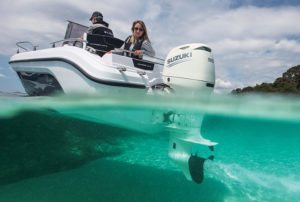
While it may be tempting to suggest that it is the lower cost of outboards which gives them an edge over sterndrives – particularly in the wake of the EPA’s evaporative emission regulations that came into effect in 2010 – the fact is that is has been rapid-fire technological development that has truly driven the market. The addition of features like digital throttle and shift, automatic trim and digital positioning systems not only make boating easier, they add tremendous value in the eyes of prospective buyers. That is particularly true today, as time-crunched professionals have less and less time to spend honing their skills on the water.
But it’s not just newbie boaters who want all the bells and whistles. The old salts do too.
“When serious boaters are ready to purchase a new boat, they want more full-featured products,” said Yamaha Marine Group President Ben Speciale. “Yamaha mechanical engine systems are very reliable and operate the engine well. I will be the first one to state, however, that once you use a digital throttle and shift engine, it’s hard to go back to mechanical again. This digital technology fully integrates boat control systems to create a unique experience for larger boats. To me, the system really makes big boats drive like smaller boats, and makes boating more approachable.”
Of course the desire for automation and easier operation exists at every horsepower level, which is why new technologies are usually quick to move across the entire product line.
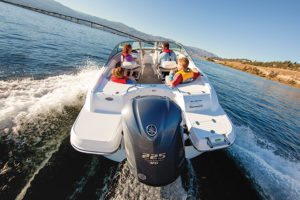
“Every boater wants to have the best experience they can have,” said Eckman. “The migration of advanced features down through the model range in outboards is a bit like the migration of advanced features in the automotive industry. Things like power steering and power windows and automatic transmissions were all introduced on premium vehicles, and today you find them even on the base models. With our launch of the G2 in the 150 horsepower class last year, we brought features like digital shift and throttle that nobody else in the industry had into that horsepower range. Power steering and automatic trim are other features that have also now become available in the 150 horsepower class. They make boating easier, and they make boating more fun.”
They also encourage boat owners to consider repowering boats they already own. Eckman notes that one of the new G2 150 models introduced last year specifically targets the repower market.
“There are a lot of new fiberglass boats being sold today, but there are a lot of existing fiberglass boats that are being repowered as well,” said Blakely. “Families appreciate the dependability and ease of ownership that comes with the technology that’s found in today’s four-strokes. Today’s consumers do their research, and when they look at the features and benefits and the value for their money, the decision to repower is usually pretty easy. Repowering an outboard boat is straightforward, and it’s an easy way to completely change the entire ownership experience.”
The fine line of costs and benefits
While advanced features clearly make boating easier, they can also add to an engine’s price tag. That’s a major reason why new technology is typically introduced on larger engines, since their typically higher margins and retail price tags help cushion development costs. Those investments are further offset when the new technology inevitably migrates down through the rest of the model lineup.
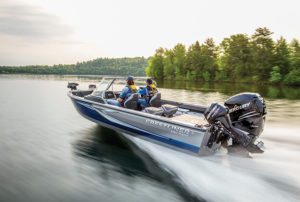
“There is always the need to strike a balance in bringing high-end features to lower horsepower,” Speciale said. “Our new lightweight 25 horsepower four stroke includes lots of new features found in larger engines. And it’s 25 percent lighter in overall weight, driven by technology from our second generation V6 four strokes. This is a balance between cost and value to the consumer.”
This balanced approach is a key reason that outboard manufacturers increasingly describe cost in terms of ownership rather than acquisition. Where a new outboard may carry a higher price tag than the engine it replaces, new technologies that improve fuel economy and reduce service requirements can significantly lower the overall cost of ownership.
“It doesn’t really matter if someone’s driving a big offshore boat in Florida or a little jon boat in Arkansas or a pontoon in Michigan, people just want to have fun in their boat,” said Ashley. “People don’t buy boats and engines, they buy what those products represent. They’re thinking about the good times they’re going to have, not what the maintenance schedule looks like. They look big picture, and that’s how we as an industry need to look at it too. We’re selling an experience, and our job is to make boating as enjoyable and carefree as possible.”

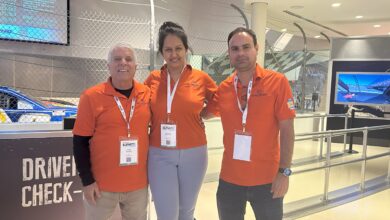


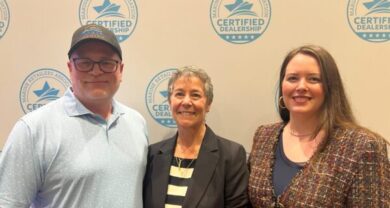

Obviously the technological development is appreciable but to increase sell the manufacturers also should give a look to all sections of buyer. Some want cheap boats and they don’t want too developed boats. As the industry is growing if the manufacturers make a plan to enter into developing countries then they can surely increase their profit I guess.
Thank you.